
Treating Sprains and luxations Page Menu: 1 2 3 4 5 6 7 8 9 10 11 12 13 Next>>
Treating Sprains & Dislocations in the Golden Age of Piracy, Page 4
Devices for Extending & Reducing Dislocations
Before discussing specific types of dislocations, it is worth taking a brief look at some of the devices that surgeons from this era employed when they needed assistance in extending a challenging dislocation. A variety of devices were used including belts/bands, balls, ladders, the coulstaff and similar devices, the crutch, the ambi, pulleys and anchoring devices, the glossocomium and the general. Most of them were devised for reducing a dislocated shoulder, although several could be used in other difficult-to-extend dislocations including the elbow, thigh, knee and ankle. Let's look at each of them.
Devices for Extending & Reducing Dislocations: Belts/Bands
The simplest devices are cloth bands or belts. Cloth or soft leather were used to wrap around the parts above and below the luxated joint so that the surgeon and his assistants could get more leverage when pulling the incorrectly seated bone away from its incorrect position to reseat it.
German surgeon William Fabry advised the use of linen in dislocations.1 Ambroise Paré
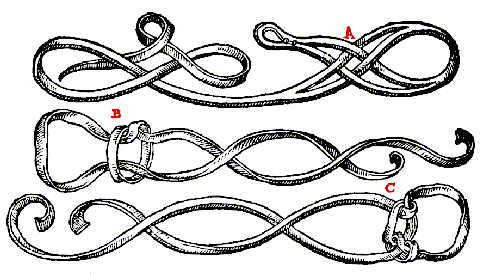
Bandages Used for Extension, From The Workes of that Famous Chirurgion Ambrose Parey (1649)
talks about the use of bandages in extending fractures, providing images of them (seen at right).
Before I come to the particular kinds of Dislocations, I think it not amiss to describe three sorts of Bandages and give you their figures, as those which are most fit to hold and extend dislocations. The first ligature, designed by this letter A, is made for holding the member. The second, marked with the letter B, is fit for the drawing or extension, and consists of one knot. The third, whereto the letter C is put, consisting of two knots, is to hold or bind more straitly [tightly]2
Nearly all the authors mention the use some form of ligature when extending a dislocation. Among them are belts, bands, towels, ropes, strings, bandages and napkins (rectangular pieces of cloth).
1 Guliielm. Fabritius Hildanus aka. William Fabry. Cista Militaris, Or, A Military Chest, Furnished Either for Sea or Land, 1676, p. 28; 2 Ambroise Paré, The Workes of that Famous Chirurgion Ambrose Parey, 1649, p. 382-3
Devices for Extending & Reducing Dislocations: Balls
Balls placed in the armpit were primarily used for padding a pole or similar surface when it was being used to reduce (force back into place) the humerus in a dislocated shoulder. Sea surgeon John Atkins recommended using a linen ball "fitted to the Hollow of the Arm Pit, for the easier fitting of a Girt [belt or brace], which is to come over that and the Shoulder, for Contra-Extension
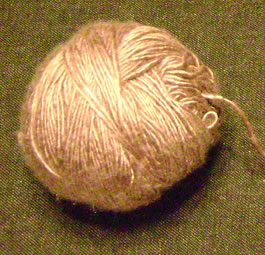
Photo: Willow W. - A Clew or Ball of Yarn
[pulling the joint away from the incorrectly seated bone, as opposed to pulling the bone away from the joint]"1. Atkins also mentions a wooden ball as being a part of another device - the crutch, where it actually served as the part which reduced the humerus. The crutch will be discussed in detail shortly.
Paré recommends using "a clew [ball] of yarn, or ball of sufficient bigness to fill up the cavity of the arm-hole."2 He elsewhere specifies that the yarn ball can be either woolen or cotten yarn.3 As an alternative, the surgeon can employ a "leathern-ball, stuffed with tow or cotton"4.
When using a ladder rung, pole or staff to repair a luxated shoulder, several surgeons recommend this type of padding. Paré specifies that a ball of yarn be fastened to such devices when adjusting both the shoulder5 and the knee6. Atkins likewise suggests the use of a ball on the ladder step.7 Richard Wiseman advises that the pole of a coulstaff should be "covered with a soft Boulster fit to place under the Patient's Arm-pit."8 Paré offers the same suggestion.9 Sea surgeon John Moyle recommends "a round Bolster [be placed] pretty hard under the Patients Armpit" when using a pole to adjust the shoulder.10 Perhaps the most curious suggesting comes from former naval surgeon James Handley: a tennis ball11. This was probably directed at his land-based readers as it would not likely be found on a ship.
Balls were also used in bandaging. Charles Gabriel Le Clerc suggests when bandaging a wrist, having "[a] small Pellet or Ball of Cloth, for the inside of the Patient's Hand, to keep his Fingers in a middle Posture"12. They also are recommended for placement in the armpit when first bandaging luxated shoulders.
1 John Atkins, The Navy Surgeon, 1742, p. 103; 2 Ambroise Paré, The Workes of that Famous Chirurgion Ambrose Parey, 1649, p. 391; 3,4 Paré, p. 390; 5 Paré, p. 391; 6 Paré, p. 395; 7 Atkins, p. 103; 8 Richard Wiseman, Severall Chirurgicall Treatises, 2nd ed., 1686, p. 488; 9 Paré, p. 389; 10 John Moyle, Chirugius Marinus: Or, The Sea Chirurgeon, 1693, p. 121; 11 James Handley, Colloquia Chyrurgica, 1705, p. 156; 12 Charles Gabriel Le Clerc, A Description of Bandages and Dressings, p. 46
Devices for Extending & Reducing Dislocations: The Ladder
Nearly all the surgeons under study suggest the use of a ladder in fixing a luxated shoulder. Sea surgeon John Atkins notes that the round step of a ladder is used with a "Compress and Ball being fitted [in]to the Axilla[armpit], and a sufficient Strength placed before at the Arm, the Weight of the Body (tripped off the Step) is to be the Contra-Extension"1. Here, the ladder step causes the humerus to be reduced while the spaces between the steps allow the patient to be positioned properly.
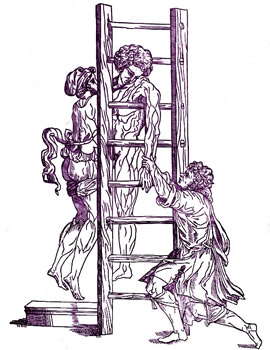
Reducing a Luxated Shoulder on a Ladder, From
Chirurgie, Medecins et malades, Pierre Gaultier (1544)
Ambroise Paré expands on this a bit, recommending the fixing of "some round body, as a ball, or clew [ball] of yarn, which... may serve to fill the arm-pit"2 to the step of a ladder as we have seen. The patient is then to stand on a low stool, have his legs tied together and his other arm secured behind his back. Standing as close as he can to the ladder, he puts his arm over the rung (as seen at right). Then, "let the stool be plucked from under his feet, so that he may hang upon the Ladder. Thus by this means the head of the Shoulder will bee restored by its self, the endeavour of the Surgeon assisting, and pressing down the shoulder-blade, and moving it to and again."3
Atkins warns that "should the Weight [of the patient's body], by such a sudden Jirk, bring but a small Part of the Os Humeri [upper arm bone] over the Step of the Ladder, there would be very great Hazard of fracturing it"4. Paré agrees, also warning his reader not to let the patient put his head through the rung. (!)
Note that in the image, the surgeon and his assistants pull on the patient's arms and body while he is hanging off the step, which might allow more control of the extension. Richard Wiseman suggests that the surgeon should have "a strong Fellow take hold of that Arm, and pull it forcibly down backward, whilst the Patient hangeth by it."5 Wiseman also suggests using a ladder to extend a difficult elbow when it can't be done by hand.6
1 John Atkins, The Navy Surgeon, 1742, p. 103; 2,3 Ambroise Paré, The Workes of that Famous Chirurgion Ambrose Parey, 1649, p. 391; 4 Atkins, p. 104; 5 Richard Wiseman, Severall Chirurgicall Treatises, 2nd ed., 1686, p. 488; 6 Wiseman, p. 492;
Devices for Extending & Reducing Dislocations: The Coulstaff, Poles and Doors
A similar method for fixing dislocated shoulders is a device Wiseman calls the Coulstaffe. Like the ladder, this allowed for both extension and reduction of a dislocated shoulder. A coulstaff is essentially a type of pole supported on the shoulders of two men that is normally used to carry heavy objects. Paré says
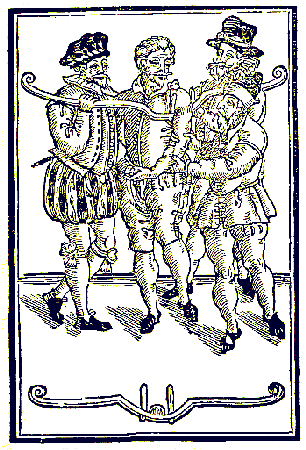
Paré's Pulley in Use, From The Workes of that Famous
Chirurgion Ambrose Parey (1649)
that it must be "some two inches broad, and some six foot long"1 recommending that the center part be covered with "a soft Boulster fit to place under the Patient's Arm-pit"2. Paré again suggests a ball of yarn which is to be pinned to the patient's clothing.
When it comes to extending the shoulder, Paré's and Wiseman's accounts diverge. Paré recommends having two men taller than the patient ('either by nature or by art') hold the coulstaff while the patient drapes his arm over it as seen in the image at left. "[T]he Surgeon must be ready to pull his hanging arm down-wards. Thus the Patient shall (as it were) hang on the perch with his shoulder, and so the head of the bone shall be forced into its cavity"3.
Wiseman's recommendation is a bit more complex. He says "the Patient must be seated near some Post or Pillar, in which the Pully must be fastened to extend his Arm; and the Bandage must be made a little above the Elbow"4. Once done, the coulstaff is placed under the patient's armpit and held by two men. "[T]he Chirurgeon must stand on the contrary side, with his Hands on each side of the Scapula, to press it downward, and keep the Patient firm in his Seat, and govern the Operation"5, presumably while the two men lift the coulstaff and he pulls on the arm which is attached to the pulley. This would at least give him some control over the tension on the arm.
Naval surgeon James Handley basically follows Wiseman's recommendation, referring to "a Pole with a Prominence fixt in the middle, which we call a Colt-staff"6. He does suggest that the patient be seated for this operation rather than standing and also connects a pulley to the arm above the patient's elbow to a post to extend the dislocated bone.
Even if a coulstaff wasn't available, there were plenty of wooden items that would serve in such a capacity. Paré notes that "a peece of Wood, laid across upon two Posts"7 can be used. He says the key is to have "a crosse pin or piece of wood must be made fast through two posts or a frame & well fastened thereto"8. He also uses recommends using a staff to adjust a dislocated knee9 and elbow10. Where the surgeon didn't have a pole, Paré employed a "doore, beds posts, and such like things as shall be there present."11
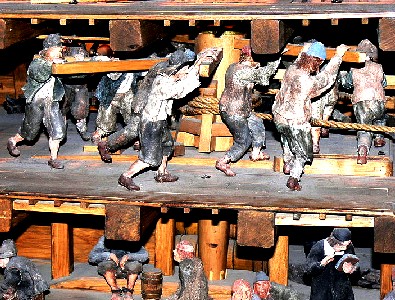
Photo: Wolfgang Sauber
Men Pushing Hand Spikes in the Capstan. Although those shown here are
square, hand spikes were often round - like a ladder rung.
A ship had a variety of items that would meet Paré's recommendation. Like Paré, John Moyle suggests using a door to extend a luxated shoulder, but he adds another, more interesting ship-specific solution:
let two Men take a Hand-spike on their Shoulders, one at one end, and the other at the other end, and set a stool or block under it, for the Patient to stand on; then put a round Bolster pretty hard under the Patients Armpit, and let his Arm be over the Hand-spike or Staff, then pull down his arm pretty tort [hard], and let a Man take hold of his Hand, and hold it fast down; and do you stand with your Hands about the Joynt to guide things right; then let one trip away the stool or block suddenly from under his Feet, the Man that hath hold of his Hand, holding hard; and the bone will by sudden weight of the Mans Body forcibly snap in.12
A hand spike is the long, removable wooden pole which men pushed on to turn the capstan on a ship. The capstan was used to wind up ropes and cables such as the anchor cables. Even if a hand spike wasn't available carpenters were nearly always found on wooden vessels, so they could have made something that would have worked equally well.
1,2,3 Ambroise Paré, The Workes of that Famous Chirurgion Ambrose Parey, 1649, p. 391; 4,5 Richard Wiseman, Severall Chirurgicall Treatises, 2nd ed., 1686, p. 488; 6 James Handley, Colloquia Chyrurgica, 1705, p. 157; 7 Paré, p. 393; 8 Paré, p. 395; 9,10 Paré, p. 393; 11 Paré, p. 396; 12 John Moyle, Chirugius Marinus: Or, The Sea Chirurgeon, 1693, p. 121
Devices for Extending & Reducing Dislocations: The Crutch
John Atkins discusses another simple device for fixing a dislocated shoulder: a Crutch. He explains, that it "is the newest Invention; skrews into the Floor, and in the Middle of the Head, a wooden Ball rises to thrust under the Arm, which fastened by proper Ligatures, there is a Jack and Pullies to make Extension by."1 Although there isn't an image available for this, its name, the way the ladder and the coulstaff work and Atkins' brief explanation provide a pretty good idea of how it would look and function.
1 John Atkins, The Navy Surgeon, 1742, p. 131
Devices for Extending & Reducing Dislocations: The Ambi or Ambee
Paré discusses one other invention for use in shoulder dislocations which he calls the Ambi, another device used to reduce a dislocated humerus. He talks about several different versions. The most elaborately figured version seen here, which was designed by Nicholas Picart. Sea surgeon John Atkins 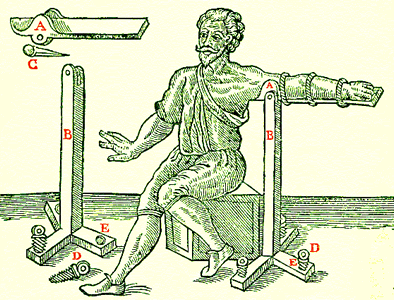
The Ambi, From The Workes of that Famous
Chirurgion Ambrose Parey, p. 394 (1649)
also mentions the 'Ambee' for use in repairing a shoulder dislocation, noting that it is "in common Use, and needs no Description, fixes under the Arm, the Length of it, and extends to what Degree you please."1
Paré explains the Picart version where the patient's arm rests on a flat wooden piece he calls a spatula (A) which is able to tilt on an iron pin C that is thrust through spatula and the top of the frame B. Like a lot of the devices which allowed the surgeon to work on dislocations from this time, the Ambi had to be screwed into the floor (using screws D & holes E) so that it wouldn't move. (Dislocation devices must have been hard on the surgeon's quarters and furniture.) Paré notes that the patient must be seated to get his arm at the proper height "that so the spatula [A] which is thrust into the arm-pit may be the more forcibly deprest, so to force in the head of the shoulder-bone; the patients feet must also be tyed, that he may not raise himselfe up whilest the Surgeon endevours to restore it."2
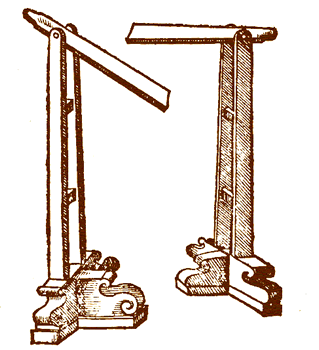
Hippocrates' Ambi, From The Workes of that Famous
Chirurgion
Ambrose Parey, p. 383 (1649)
Paré recommends another type of Ambi which he explains is of "such a height that the Patient may stand on tip-toes. Now this is the very best way of restoring a shoulder."3 Unfortunately, he does not show it in use, but the principle is still basically the same as those seen here.
There are some things Paré recommends for preparing the Ambi for use. He tells the surgeon "the spatula must be wrapped about with a linnen or woollen rag, or some such soft thing, that it may be the softer, and hurt the less; and then it must be so thrust under the arm-pit, that it may throughly penetrate into the inner part between the ribs, and the head of the shoulder-bone."4 (This is basically a variation on the ball concept discussed previously.) Although neither of his drawings show it, he also advises the Spatula (A) have "two holes in three severall places, each alike distant from other, through which let soft strings be put, whereby it may be tyed to the arm, stretched all the length thereof even to the fingers, in one place a little below the head of the shoulder-bone, in another a little above the elbow, and the third at the wrist, that so they may hold it firm."5
Once the arm is tied securely to the spatula and the end nearest the hinge positioned under the dislocated bone, relocation is performed "by pressing down the other end of the spatula which goes to the hand, [by which] the bone is forced into its cavity. "6
1John Atkins, The Navy Surgeon, 1742, p. 104; 2,3 Ambroise Paré, The Workes of that Famous Chirurgion Ambrose Parey, 1649, p. 393; 4 Paré, p. 392; 5 Paré, p. 392-3; 6 Paré, p. 393
Devices for Extending & Reducing Dislocations: Paré's Pulley and Anchors
One of the most widely used complex devices for extending various dislocations was the pulley. Paré includes a drawing of his pulley-based device which is "made for to draw and extend more powerfully, when the hand will not serve. It is made like a Pulley, marked with these letters D D."1
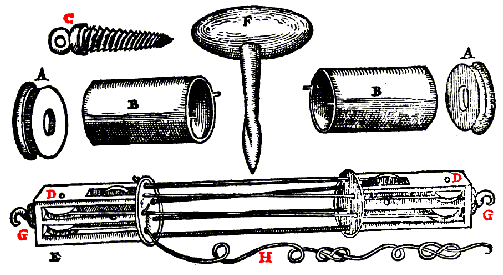
A Pulley for Extension, From The Workes of that Famous Chirurgion Ambrose Parey (1649)
He notes that there are three sets of pulleys inside, which are operated by pulling the rope marked H. The two hooks (G) are used to secure this device. One end is connected to a post or similar secure object using the eye screw C. The other is teid to a ligature wrapped around the bpdu part to be extended.
Paré has shown the device with the covers (As and Bs) removed so that the reader can have a similar device made from his drawing. When operating, these covers would be in place to keep the pulleys covered and the operator and patient protected from them. He also shows a gimlet lettered F used to make a hole in for the eye screw (C).
Paré's device includes six pulleys of identical size, which gives a (theoretical) mechanical advantage of twelve. This means that if the pulleys were perfectly efficient (there was no slipping, stretching, friction, loss of energy or similar problems with the equipment) , one pound of pulling force on rope H would be multiplied into twelve pounds of pulling force between the hooks G left and G right. Of course, there is no such thing as an ideal situation in physics so the actual force advantage would probably be more around eight to ten. This is still a big advantage over pulling directly on a limb!
Other surgeons found Paré's pulley useful as well. While he doesn't go into detail about its use, sea surgeon John Moyle says that when repairing a dislocated shoulder, "if you have [it], that is the best Instrument in this case."2 German surgeon William Fabry says "I have always found in my practice the Instrument of Ambroise Parey, which is with a Pulley, the most convenient [device to use in dislocations]"3. Fabry goes so far as to simplify Paré's drawing and include it in his book. Richard Wiseman recommends it for dislocations of the shoulder4, thigh5 and ankle6. Sea surgeons John Moyle7, James Handley8 and John Atkins9 advise its use in extending a luxation of the thigh. Paré himself suggests it for dislocations of the shoulder10 and thigh11.
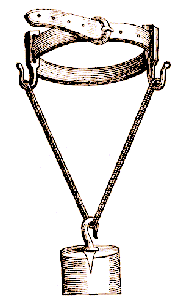
Girdle, From Opera quea extant
omina,
By William Fabry, p. 478 (1682)
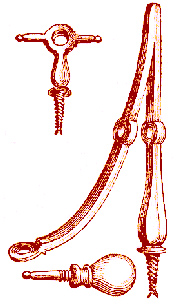
Remora, From Opera quea extant
omina,
By William Fabry, p. 478 (1682)Fabry states that Paré's pulley "is not onely the most convenient, but most useful Instrument for all Fractures and Dislocations, except of the Fingers, Ribs, and Mandibles"12. Although Paré includes eye hooks in his diagram, Fabry shows other devices that allow the surgeon to adapt it to specific types of dislocations. He explains that the pulley is very useful "especially if you joyn to it the Girdle and Remora"13.
Fabry's girdle is a belt with hooks on either side to which ropes and the pulley can be connected when working on a dislocated thigh. This is seen in the image at left. His remora is to be screwed into a wooden surface and used to hold the patient steady while a ligature or other device such as Paré's pulley is being used to pull the joint. The image at right shows the parts of the device including a screw for holding it down to the table and a pin with a ball on top which is placed in the armpit of the patient through the two holes in the middle. The image below shows how it is used to repair a luxated shoulder.
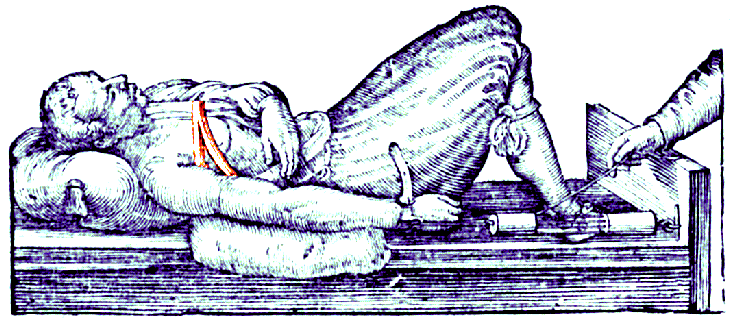 Using the Remora (highlighted in red) with Paré's Pulley, From Opera q`uea extant omina, By William Fabry, p. 483 (1682) |
1 Ambroise Paré, The Workes of that Famous Chirurgion Ambrose Parey, 1649, p. 383; 2 John Moyle, Chirugius Marinus: Or, The Sea Chirurgeon, 1693, p. 103; 3 Guliielm. Fabritius Hildanus aka. William Fabry. Cista Militaris, Or, A Military Chest, Furnished Either for Sea or Land, 1676, p. 27; 4 Richard Wiseman, Severall Chirurgicall Treatises, 2nd ed., 1686, p. 488; 5 Wiseman, p. 495; 6 Wiseman, p. 498; 7 Moyle, p. 124; 8James Handley, Colloquia Chyrurgica, 1705, p. 157 & 160; 9John Atkins, The Navy Surgeon, 1742, p. 108; 10 Paré, p. 389; 11 Paré, p. 392 & 394; 12,13 Fabry, p. 27
Devices for Extending & Reducing Dislocations: The Glossocomium
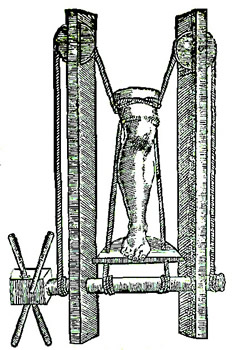
The Glossocomium, From The Workes of that
Famous Chirurgion Ambrose Parey, p. 371 (1649)
The Glossocomium was invented by esteemed ancient physician Galen of Pergamon, being used to extend limbs. Although Ambroise Paré does not mention the Glossocomium in connection to luxated joints, he shows and explains it in his discussion on treating fractures (seen at right). Its function is fairly straightforward thanks to Paré's drawing. Ropesor cords are tied above and below the part to be extended. The upper ropes feed up to pulleys and then back down to the cranking device below. The lower ropes feed directly down to the crank. Turning the crank results in the part being simultaneously pulled down for extension and up for counter-extension. (A fractured femur is being extended in this drawing. However, if the lower rope were tied to the lower part of the leg, it would extend the knee.)
The Glossocomium was not considered the most desirable way to extend and repair dislocated joints. Richard Wiseman says it "is of use in the most strong tough Bodies, and where the Luxation hath been of long continuance, and will not yield to the other ways of Extension. There ought to be great care in the use of it, for many shrewd Accidents have happend thereby."1 Even though Paré shows the device, he quickly dismisses it when discussing treating fractures of the hip, stating that it was used by 'the ancients'. He recommends "[i]n stead of this Glosocomium, you may make use of my Pulley"2. Sea surgeon James Handley only mentions the Glossocomium briefly, similarly advising it be used with caution.3
1 Richard Wiseman, Severall Chirurgicall Treatises, 2nd ed., 1686, p. 488; 2 Ambroise Paré, The Workes of that Famous Chirurgion Ambrose Parey, 1649, p. 383; 3 James Handley, Colloquia Chyrurgica, 1705, p. 157
Devices for Extending and Reducing Dislocations: The Commander
Sea surgeon John Woodall is effusive in his praise for the Commander, a device he learned about while stationed in Poland. It is one of three devices discussed here which can both extend and reduce a dislocated bone. (The other two being the Ladder and the Coulstaff.) It is the only device that can perform these operations on more than one type of dislocation. Unfortunately Woodall doesn't show an image of his Commander and it is difficult to envision from his words alone.

The Glossocomium Combined with a Ladder Used on a Patient Lying Down, From
Florentini Opera Varia Hippocrates Galen, By Vidi Vidii, p. 497 (1599)
Looking for other mentions of the Commander as a way to extend and reduce fractures turns up a variety of theml. French surgeon M. de La Vauguion says the "Amby [ambi] of Hippocrates known to our Surgeons by the Name of the Commander"1. Woodall's description has some things in common with the Ambi, but he used it for extensions of the thigh, knee and ankle which would usually be performed while the patient was lying down. So it is not the ambi. Several surgeons note that 'Commander' is a common name for the Glossocomium2discussed previously. Although that can be used lying down (see the image at left), Woodall's description mentions features the Glossocomium would not have. So it is not that either.
A paper presented to the Royal Society by St. Bart's hospital surgeon John Frekes in 1742 shows and device he calls the Commander, which sounds much more like the device Woodall describes. Let's compare them.
Woodall's begins noting that his Commander has an "Iron ginne ['ginne' is short for engine3 - the mechanical part of the device] which... [is] at the lower end of the Commander, where are certaine holes with one Iron pinne for diversities of the lengths of limes [limbs] to be extended, this ginne having a resting place ...to stay it [hold it] to the pinne recited"4. The pin allows adjustment of the mechanical part of the device so that it can be matched to the size of the limb being extended, although it is not clear how. Woodall mentions a strong leather band or cord the connects a towel which is tied below the joint to be extended and "the upper part or teeth of the Iron instrument"6. Woodall also refers to turning (or cranking) a handle to make his instrument work.
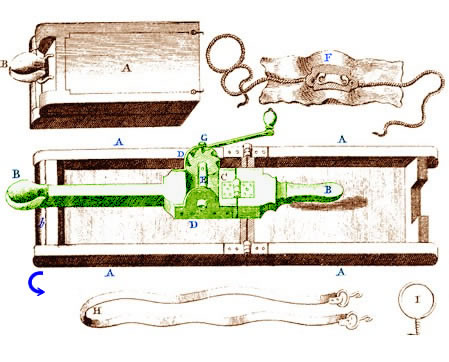
Diagram of Freke's Commander, From"X. The Description of an Instrument for reducing
a dislocated Shoulder...", Philosophical Transactions, 1 January 1742
Freke provided a diagram of his Commander, which is seen at right. The key to this from Woodall's description is the part highlighted in green which Freke calls the Lever (B-B). Here we have an engine (marked by D, G, E and D), a piece of material which appears to have cords and a towel for attaching to the limb (F) and a part with teeth (G). Freke's band and towel arrangement looks a bit more complex than Woodall described, but it fits the general concept. The two cords on F are fed into two holes on the round iron cross piece E. This is then tightened by turning the handle. The notched wheel G is used as a rachet with a spring catch to keep the engine from slipping backwards after it has been tightened to extend the joint. The only thing missing is Woodall's iron pin for adjustment of the device's length. Although it can't be stated for certain, it is possible that if Woodall's Commander was like Freke's, it allowed one side of the green lever to be slid open to make it longer.
Woodall also talks about his Commander having a 'button' which is "somewhat flatte on both sides, not round"7. This is fitted into the armpit when adjusting a luxated shoulder with "the end of the recited button being well armed with tow [linen] bound on with a cloute [piece of cloth]"8. Woodall's button serves the same purpose as the ball which is used with several devices used to force the humerus into place on a downwardly dislocated shoulder. The round piece sticking out over the edge of Freke's box is what Woodall would call the button, being placed in the patient's armpit while extending a dislocated shoulder. Similar to Woodall, Freke notes this knob is to be "covered with Buff Leather, for the more easy Reception of the Head of the Os humeri."9
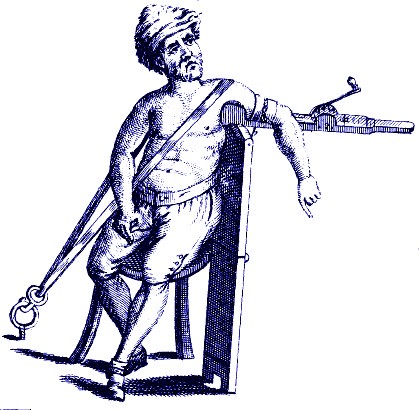
Using Freke's Commander, From"X. The Description of an Instrument for reducing
a dislocated Shoulder...", Philosophical Transactions, 1 January 1742
One big difference is between the range of use of Freke's Commander when compared to Woodall's. Freke has specifically designed his invention for use on a luxated shoulder while Woodall uses his Commander for dislocations of the shoulder, elbow, thigh, knee and ankle.
However, the two seem to agree on the method for using a Commander when treating a dislocated shoulder. Freke includes an image of it in use. Woodall's description says the commander is to be placed "just of height with [the same height as] the party [the patient], I meane from the place where it is to be placed to the ground"10. Freke's wooden tray (marked with As in the previous diagram) would make his Commander function like an Ambi without restricting it to be used in this way only.
This image at left provides an opportunity to explain how the lever worked to extend a limb. Cranking the handle band would pull the bone being extended (in this case the humerus) away from the joint (here the shoulder). With the tray being added, the surgeon would have leverage when pushing against the head of the humerus with the button.
However, here the two depart; Woodall had more uses for his Commander. When extending a patient's thigh,
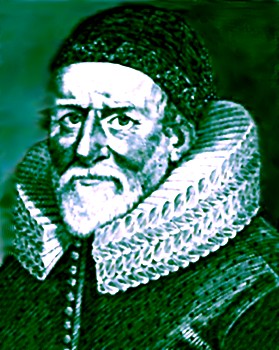
Sea Surgeon John Woodall
Woodall counsels that "the button on the top must be taken off, and a cushion bound on the place thereof"11. which would almost certainly be placed in the patient's crotch which is recommended for one of the methods of extensions of a dislocated thigh. Then the device must have the parts "placed, tied, and fastned... together"8 so that the leg could then "be gently bound to the Commander as is said of the [patient's] arme [when extending the elbow]"12. This is why it seems unlikely that the tray would have been a permanent part of Woodall's Commander - it would have made it difficult to tie to an arm or leg. Freke's lever was permanently attached to the tray as we shall see. Still, it is quite possible that Freke's lever was an adaptation of Woodall's Commander.
When using his Commander, Woodall advises his readers "to turne the extending instrument, and turne it gently till all [the bands or ropes] bee reasonable stiffe"13. Two assistants are then to hold the patient while "with thy owne hands seeke to reduce the bone: I have often found when I have extended to a just length, the bone hath of it selfe returned to his place, thou wilt wonder at the facility thereof, if thou proceed orderly"14. Woodall warns that practise is the key to restoring a dislocation, advising the "once using it [the Commander], thou wilt finde it out."15
Although Freke's design came after the end of the golden age of piracy and is not correct to the period, it would be a shame not to mention some of the clever things he included in his design having seen his diagram. Freke explains that his Commander may "easily be made use of, without

Surgeon John Freke (18th c.)
the Assistance of any other Operator than the Surgeon employed"16. To facilitate this, he shows a band H and eye-ring I in his schematic which are used to provide counter-extension to the Commander. Their function is found in the previous image where they are holding the patient's shoulder.
Freke also made his device hinged so that it folded up to be about twenty inches long and nine across for convenient transportation. (You can see it closed and locked shut in the top left corner of his diagram.) Since none of these things are mentioned by Woodall, they would not have been part of his device. Freke's Commander was so well made, it continued to be recommended for 80 years after he publishing its design, being called "a much better instrument than any of them [used on dislocated shoulders], or indeed than all"18.
Of course, this is just one possibility. Two other devices that have a variety of features which also fit Woodall's vague description are presented below, although they will not described in detail here. The first is designed by Mathias Gottfried Purmann and the second by Johann Helfrich Jüngken. Their basic functions are fairly easy to see from the images; they each use a type of rack and pinion engine to extend the arm. Although different in mechanical design, most of the basic elements of these two devices match those mentioned by Woodall almost as well as Freke's Commander does - they have a gear-based engine, a cranking handle, a wooden base and the potential to have pins to adust the length of the device. It is likely that Woodall's Commander was, if not exactly like one of them, of a similar design.
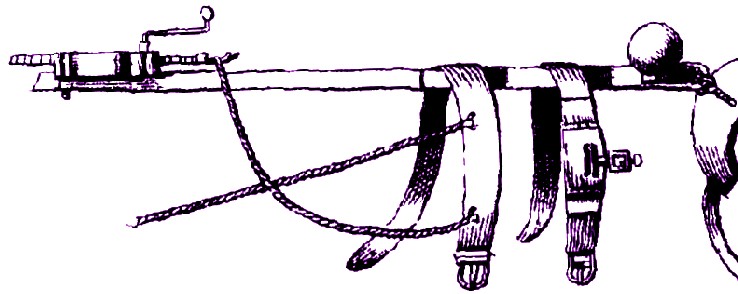 A Shoulder Reduction Device, Designed by Mathias Gottfried Purmann, From Chirurgia Curiousa (1699) |
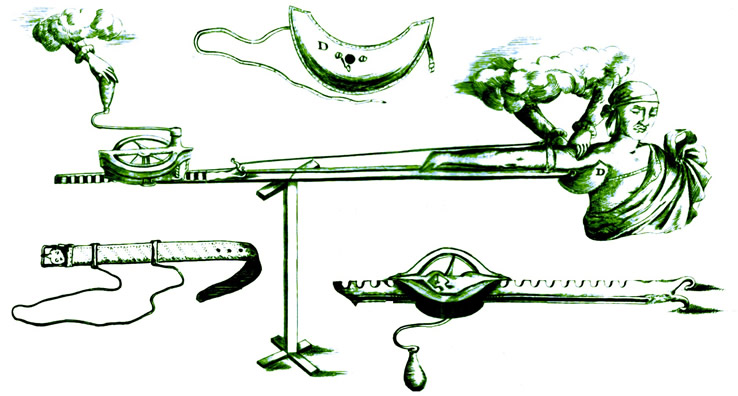 Another Shoulder Reducing Device, Designed by Johann Helfric Jüngken, From Acta Erudiitorium (1683) |
1 M. de La Vauguion, A Compleat Body of Surgical Operations, 1707, p. 436; 1 Richard Wiseman, Severall Chirurgicall Treatises, 2nd ed., 1686, p. 488 & James Handley, Colloquia Chyrugica, 1705, p. 157; 3 Edward Phillips, "Ginne", The New World of Words, 1671, not paginated; 4 John Woodall, the surgions mate, 1639, p. 155; 5 Woodall, p. 156; 7,8 Woodall, p. 155; 9 John Freke, "X. The Description of an Instrument for reducing a dislocated Shoulder...", Philosophical Transaction, 1742-1743, published 1 January 1742, p. 557-8; 10 Woodall, p. 155; 11,12 Woodall, p. 156; 13,14,15 Woodall, p. 156; 16 Freke, p. 557; 17 Freke, p. 558; 18 Samuel Cooper, A Dictionary of Practical Surgery, 1822, p. 359
Devices for Extending Dislocations/Luxations: A Problem
In closing the topic of using machine to reduce fracture, Atkins makes one final, yet interesting, comment. It is not to recommend any particular device. Instead, he says, "Instruments, I think, do not equally extend the Bone with the Muscles; they tear and distend their Fibres, when the Extension (where it ought to be) is what may be compassed with the Hands more commodiously, because your perceive the Head of the Bone moving, and can move more seasonably help to raise it up."1
1John Atkins, The Navy Surgeon, 1742, p. 104

